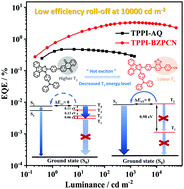Non-doped organic light-emitting diodes based on phenanthroimidazole-triphenylamine derivatives with a low efficiency roll-off of 9% at a high luminance of 10 000 cd m−2†
Abstract
Simultaneously achieving high exciton utilization efficiency (ηS) and a low efficiency roll-off at high brightness is challenging for fluorescent organic light-emitting diodes (OLEDs). In this work, we tried to realize this goal by constructing “hot exciton” materials by fine-tuning the lowest triplet excited state (T1) features. Two phenanthroimidazole-triphenylamine based donor–acceptor (D–A) derivatives TPPI-AQ and TPPI-BZPCN have been designed and synthesized. The photophysical studies and theoretical calculations reveal that TPPI-BZPCN has an obvious “hot exciton” feature and an aggregation-induced emission (AIE) characteristic. A big gap between T1 and T2 exists in TPPI-BZPCN which provides the possibility for a reverse intersystem system crossing (RISC) process from the upper energy level of T2 to S1. As a result, the non-doped electroluminescent device based on TPPI-BZPCN achieves a maximum external quantum efficiency (EQE) of 3.33%. The electroluminescence (EL) spectrum exhibits an emission peak at 592 nm, and the brightness can be up to 55 657 cd m−2. Also, the device is able to retain an EQE of 3.03% at the high luminance of 10 000 cd m−2, with a very low efficiency roll-off of 9%, which is the lowest efficiency roll-off currently reported in the orange-red emitters based on the “hot exciton” mechanism. Moreover, the ηS of the non-doped device reaches 48%, which exceeds the limitation of 25% in conventional fluorescence OLEDs.



 Please wait while we load your content...
Please wait while we load your content...